Abstract
To support the coexistence of long-term evolution (LTE)-license-assisted access (LAA) and wireless local area network (WLAN) in unlicensed bands, the load-based listen-before-talk (LB-LBT) scheme has been developed, incorporating channel sensing and backoff functions similar to those used in WLAN. In the LB-LBT scheme, the contention window size and clear channel assessment (CCA) threshold of the LTE-LAA eNodeB (eNB) significantly influences its transmission probability and the interference caused by concurrent WLAN transmissions outside the CCA range. However, most existing LB-LBT schemes use fixed contention window sizes and CCA thresholds, irrespective of the channel congestion status. To address this limitation, in this paper, we propose a channel measurement-based LBT (CM-LBT) scheme to enhance overall system throughput while ensuring fairness between LTE-LAA and WLAN systems. Our proposed CM-LBT scheme adaptively adjusts the contention window size and CCA threshold of LTE-LAA eNB in the LB-LBT scheme, according to the current channel access activities of LTE-LAA and WLAN systems. Through simulations, we evaluate the performance of our proposed CM-LBT scheme against existing LBT schemes by assessing the throughput of LTE-LAA and WLAN systems, as well as the fairness between them, using a reward function.
1. Introduction
With the proliferation of mobile devices and diverse mobile applications, mobile network operators are experiencing phenomenal mobile data growth worldwide [1]. To meet this challenge, mobile network operators have increased frequency reuse and area spectral efficiency by deploying many small cell base stations [2]. Because the small cells currently operate on licensed bands, the network capacity should be upper-bounded by the availability of these licensed bands. This motivates the operators to utilize the readily available unlicensed spectrum. Thus, 3rd Generation Partnership Project (3GPP) has recently initiated a study item on standardized Long Term Evolution (LTE)-License-Assisted Access (LAA) technology to satisfy increasing mobile traffic demands in cellular systems. However, a major concern highlighted by the 3GPP is the issue of ensuring an efficient coexistence between LTE-LAA and other existing unlicensed systems, especially widely deployed wireless local area networks (WLANs).
Without appropriate coexistence considerations, the operation of LTE-LAA systems may incur continuous interference with WLANs because the latter rely on contention-based medium access control and will back off when detecting LTE-LAA transmissions. The European Telecommunications Standards Institute (ETSI) presented a listen-before-talk (LBT) specification for time-frame-based devices to enable the channel to be shared with the incumbent WLAN systems [3]. LTE-LAA with the LBT feature was included in 3GPP Release 13 as a global standard for coexistence in the unlicensed band [4]. In the ETSI specification, two types of LBT schemes are defined: frame-based LBT (FB-LBT) and load-based LBT (LB-LBT). In FB-LBT, the LTE-LAA eNodeB (eNB) is required for listening to the target channel to detect the energy level during a certain interval, the clear channel assessment (CCA) period, before transmission. The LTE-LAA eNB can occupy the channel for a fixed duration, known as the channel occupancy time, only if the interference level is below a predefined CCA threshold. In FB-LBT, the CCA period is fixed to a specified duration, regardless of the channel congestion status. As a result, the unlicensed spectrum is occupied by the WLAN system far more frequently than by the LTE-LAA system, particularly when the WLAN network is congested [5]. This occurs even when the LTE-LAA eNBs have data to transmit. Moreover, when LTE-LAA is used for supplementary downlink purposes, a single LTE-LAA eNB must compete with multiple WLAN nodes for channel access. Consequently, the LTE-LAA eNB often fails to access the channel, as it is frequently sensed as busy with a high probability [6].
To address this issue, LB-LBT mechanisms have been extensively studied [7,8]. These mechanisms incorporate sensing and backoff functions, similar to the IEEE 802.11 distributed coordination function, in addition to the original LTE medium access control scheduling. Jeon et al. [7] demonstrated through simulations that the CCA threshold and contention window size are critical for balancing the performance between LTE-LAA and WLAN systems. The contention window size defines the maximum time the LTE-LAA eNB waits before initiating data transmission, while the CCA threshold specifies the interference level used by the LTE-LAA eNB to determine whether the channel is idle or busy. Jeon et al. showed that these parameters must be carefully configured to effectively protect nearby WLAN transmissions while avoiding excessive protection.
In the LB-LBT scheme, the contention window size and CCA threshold of the LTE-LAA eNB have a significant impact on its transmission probability and the interference caused by concurrent WLAN transmissions outside the CCA range. However, in most existing LB-LBT schemes, the contention window size and CCA threshold remain fixed. Song et al. [8] identified the optimal contention window size for maximizing total throughput in the unlicensed band under a saturated traffic assumption. Nevertheless, using saturation load models for the IEEE 802.11 distributed coordination function does not allow for accurately predicting an optimal contention window size to maintain fairness between LTE-LAA and WLAN systems, as most real-world applications do not operate under saturation conditions [9,10]. For instance, consider a scenario where one LTE-LAA eNB and ten WLAN nodes share the unlicensed spectrum. Under saturated traffic conditions, all ten WLAN nodes would always have packets ready for transmission. However, in real wireless networks, a more common scenario might involve only one WLAN node operating under saturation, while the remaining nine nodes transmit sporadically. In such cases, the contention window size of the LTE-LAA eNB must be sufficiently large to balance the traffic load between LTE-LAA and WLAN systems, contrasting with the assumptions made under saturation models.
Therefore, in this paper, we propose a channel measurement-based LBT (CM-LBT) mechanism that adaptively controls both the CCA threshold and contention window size with consideration of the congestion status in both LTE-LAA and WLAN systems. Accordingly, the proposed CM-LBT mechanism can balance the traffic between LTE-LAA and WLAN systems with the ultimate intention of enhancing the total system throughput in the unlicensed band. Through simulations, we show that the proposed mechanism improves the overall system throughput compared to existing LBT mechanisms, including the fair LBT (F-LBT) algorithm proposed in [5]. The major contributions of this paper are summarized as follows:
- To control the contention window size and CCA threshold under typical network conditions, we introduce a non-saturated Markov chain model for the LTE-LAA eNB behavior. It captures the channel access activities of both LTE-LAA and WLAN systems in the unlicensed band.
- We additionally set the appropriate CCA threshold by jointly considering the transmission and collision probabilities of WLAN nodes inside the CCA range and the interference at an LTE-LAA device from concurrent WLAN transmissions outside the CCA range.
- Furthermore, we conduct simulations to evaluate the performance of our CM-LBT scheme by assessing the throughput of both LTE-LAA and WLAN systems, as well as the fairness between them using a reward function. Additionally, we compare the performance of our proposed scheme with F-LBT and conventional LB-LBT schemes.
2. Related Work
In this section, we classify LBT mechanisms into two categories: FB-LBT and LB-LBT. We outline the operation of LBT in each category and discuss representative existing studies. In addition, we present recent studies addressing the coexistence of LTE-LAA and WLAN systems. Table 1 summarizes the existing studies.

Table 1.
Summary of studies on the coexistence of LTE-LAA and WLAN systems.
2.1. Frame-Based LBT Schemes
Because the existing LTE system operates on a fixed frame period, the FB-LBT scheme, which also follows a fixed frame period, is easier to implement in the LTE-LAA system compared to the LB-LBT scheme. In an FB-LBT-based LTE-LAA system, a single frame consists of 10 subframes. During the duration of a single frame, the LTE-LAA eNB transmits data over multiple subframes while including one or more idle subframes where no data transmission occurs. During the idle subframe duration, WLAN APs or nodes transmit data. For consecutive idle subframes, the LTE-LAA eNB begins channel sensing during a predefined sensing period before the end of the last subframe’s duration. If the channel is sensed as idle during the sensing period, the LTE-LAA eNB begins data transmission in the next subframe. However, if the channel is sensed as busy, the LTE-LAA eNB continues channel sensing for each subsequent subframe until it detects the channel as idle during the sensing period.
Ref. [5] proposed an F-LBT scheme that allocates an appropriate number of consecutive idle subframes following the LTE-LAA eNB’s data transmission, enabling WLAN APs or nodes to perform data transmission. The F-LBT scheme determines the number of idle subframes to allocate based on fairness between LTE-LAA and WLAN systems, as well as the overall system throughput. Ref. [6] proposed an analytical model to evaluate the throughput in a coexistence scenario involving FB-LBT-based LTE-LAA and WLAN systems.
2.2. Load-Based LBT Schemes
The LB-LBT scheme was proposed for its flexible spectrum utilization and adaptability to varying traffic loads [7,8]. Figure 1 illustrates the operation of the LB-LBT scheme in the unlicensed band. The scheme employs backoff functions similar to those used in WLAN.
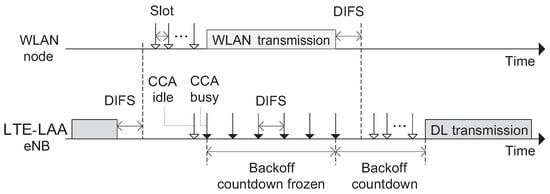
Figure 1.
LB-LBT scheme for LTE-LAA and WLAN coexistence.
The LTE-LAA eNB first listens to the target channel to detect the energy level over a time period equal to a distributed inter-frame space (DIFS). If the detected energy level is below the predefined CCA threshold, the LTE-LAA eNB proceeds with transmission. Otherwise, if the channel is sensed as busy, it continues monitoring until the channel is deemed idle for a DIFS. Once the channel is idle, the LTE-LAA eNB selects a random number between 0 and the predefined contention window size, counting down that number of idle slots before initiating transmission. Unlike WLAN nodes, which use a binary exponential backoff in the event of a collision, the LTE-LAA eNB maintains a fixed contention window size regardless of collisions.
Ref. [7] simulated a coexistence scenario between LB-LBT-based LTE-LAA and WLAN, analyzing how the contention window size and CCA threshold of LTE-LAA eNB affect throughput performance. Ref. [8] proposed a mathematical model to analyze the throughput of LTE-LAA and WLAN systems with respect to the contention window size of LTE-LAA eNB employing the LB-LBT scheme.
2.3. Recent Studies on the Coexistence Between LTE-LAA and WLAN Systems
Recent studies have explored various approaches to address the coexistence between LTE-LAA and WLAN systems. Ref. [1] formulated a non-linear integer programming problem to allocate resource blocks at the LTE-LAA eNB, aiming to ensure the fair use of the unlicensed spectrum for both LTE-LAA eNB and WLAN systems. Ref. [11] proposed a medium access control protocol leveraging physical-layer interference suppression techniques to mitigate cross-technology interference and enhance spectrum efficiency and fairness. Ref. [12] developed sensing techniques to accurately estimate operational parameters, such as the contention window size and CCA threshold, for LTE-LAA transmissions through the APs of WLAN systems. Ref. [13] developed multi-antenna multi-user transmit precoding and power control techniques performed at LTE-LAA eNBs to regulate the transmissions of WLAN APs. Ref. [14] formulated a problem to jointly optimize the transmission probability and rate of the LTE-LAA system, aiming to maximize throughput while ensuring fair usage of unlicensed channels between LTE-LAA and WLAN systems. Ref. [15] analyzed the performance of LB-LBT in the LTE-LAA system, taking into account the GAP period, which represents the required waiting time for the LTE-LAA eNB before data transmission.
3. Proposed CM-LBT Scheme
The aforementioned existing LB-LBT schemes use fixed contention window size and the fixed CCA threshold at LTE-LAA eNB. Our CM-LBT scheme controls the contention window size and CCA threshold by considering both the total system throughput and the fairness between LTE-LAA and WLAN systems. We assume a scenario in which one LTE-LAA eNB and multiple WLAN nodes, including WLAN access points (APs) and nodes, share the unlicensed spectrum, while LTE-LAA eNB is used as a supplemental downlink for the LTE technology operation using the licensed band [16].
In this section, we first present an approach to estimating the throughput of LTE-LAA and WLAN systems according to the different contention window sizes and CCA thresholds. We then describe the determination of the contention window size and CCA threshold at LTE-LAA eNB. Table 2 summarizes the notations used in this paper.

Table 2.
Notations in the proposed system.
3.1. System Model and Transmission Probability of LTE-LAA eNB
We adopt the LB-LBT procedure with a fixed contention window size for LTE-LAA eNB described in Section 2.3. The behavior of LTE-LAA eNB from applying our CM-LBT procedure is modeled as a non-saturated Markov chain [9]. From this non-saturated Markov chain, we can obtain the probability that the LTE-LAA eNB is attempting transmission in the unlicensed band. This LTE-LAA transmission probability is used to estimate the throughput of LTE-LAA and WLAN systems in Section 3.3.
Our model introduces two stages, and for , where W is the chosen fixed contention window size of LTE-LAA eNB, as shown in Figure 2. Since a single LTE-LAA eNB shares the channel with multiple WLAN nodes, it employs two backoff stages, as shown in Figure 2, to ensure the transmission rate, even in the presence of collisions, unlike WLAN. The first and second stages are called post-backoff and backoff, respectively. The post-backoff stage, , represents LTE-LAA eNB with the transmitted packet; however, it has no packets waiting. Conversely, LTE-LAA eNB must have a packet awaiting transmission in the backoff stage. The counter of the backoff stage, k, is initially uniformly chosen between and is decremented while the medium is idle.
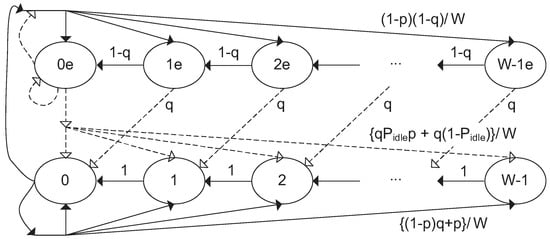
Figure 2.
Non−saturated Markov chain model for LTE-LAA eNB behavior.
We assume constant probability that the LTE-LAA eNB buffer will have no packets awaiting transmission at the start of each counter decrement. This enables us to derive relationships between the following variables: q, the probability of at least one packet awaiting transmission at the start of a counter decrement; p, the probability of a collision given that LTE-LAA eNB is attempting transmission; P, the Markov chain transition matrix; b, the chain’s stationary distribution, and , the stationary distribution’s probability that the LTE-LAA eNB will transmit in a slot.
Under the above assumptions, for , we have the following:
When the counter reaches 0 and a packet is queued, a transmission is initiated. If other WLAN nodes transmit at the same time, a collision occurs. In the case of a collision, we choose a random backoff counter again between . In the case of a successful transmission, we return to the post-backoff stage, , and the LTE-LAA eNB buffer is empty with probability . Accordingly, for , we have the following:
The final transitions are from the state, where post-backoff is complete, but the LTE-LAA eNB buffer is empty. In this case, this state is maintained if the station buffer remains empty. Then, a packet arrives. If the transmission succeeds, we return to the post-backoff stage. Otherwise, if a collision occurs or the medium is busy, we again begin the backoff stage. With denoting the probability that the medium is sensed as idle during a typical slot, the transitions from the state are as follows:
Given p, , q, and W, we can determine the stationary distribution of this Markov chain. This enables us to determine the probability, , that an LTE-LAA eNB is attempting transmission in a typical slot.
With and denoting the stationary probabilities of being in states and , we can obtain the normalization condition as follows:
We write all probabilities in terms of and use the normalization in Equation (4) to determine . The keystone is the determination of to tackle the chain. A transition into from occurs if there is an arrival, the medium is sensed as idle, and no collision occurs. In addition, it occurs from if neither a collision nor an arrival occurs. Thus, we have the following:
We then have for , with on the left side replaced by if . Straightforward recursion leads to expressions for in terms of and . Accordingly, we have the following:
Using these equations, we determine the first sum in Equation (4) as follows:
The chain can then be tackled, starting with the following relation:
Iteration leads to
The LTE-LAA eNB attempts transmission when it is in state or state , a packet arrives, and the medium is sensed as idle. Thus, . Then, given the contention window size, W, the probability that the LTE-LAA eNB will attempt transmission is as follows:
where can be determined using Equations (4), (7), and (9), so that is solely expressed in terms of p, , q, and W. In Section 3.3, we discuss how to model p, , and q by determining the relation between the LTE-LAA eNB and WLAN nodes that are competing for the medium.
3.2. Clear Channel Assessment at LTE-LAA eNB
The CCA threshold is an important component in the LBT-based coexistence system because it is the level of sensitivity required for detecting the existence of ongoing transmissions. In particular, controlling the CCA threshold at LTE-LAA eNB plays a key role in the performance of LTE-LAA and WLAN systems [7]. Lowering the CCA threshold makes the LTE-LAA eNB more sensitive to ongoing WLAN transmissions. Therefore, it refrains from transmitting more frequently. Conversely, a high CCA threshold increases interference from concurrent WLAN transmissions. In this situation, we develop an analytical model to investigate the LTE-LAA eNB transmission rate according to the CCA threshold. In Section 3.3, we then estimate the throughput of LTE-LAA and WLAN systems based on this model.
We consider a scenario where LTE-LAA and WLAN systems coexist, as illustrated in Figure 3. It is assumed that LTE-LAA eNB uses an omnidirectional antenna and transmits with fixed power . Let denote the radius of the interfering range. We then assume that a WLAN APs or nodes in the interfering region can cause interference with the LTE-LAA device. With and denoting the radius of the CCA range and CCA threshold, respectively, we employ a propagation model to obtain as follows [17]:
where K is a constant and is the propagation loss exponent.
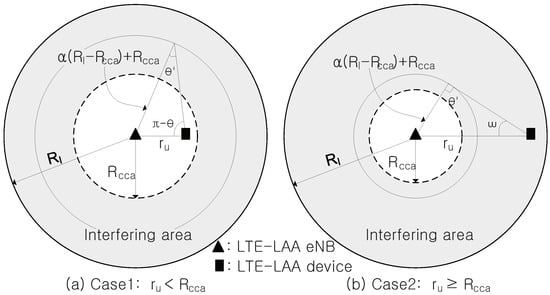
Figure 3.
Interference from WLAN systems when LTE-LAA device u is located (a) inside and (b) outside the CCA range of the LTE-LAA eNB (the shaded area is the interfering area).
Let us consider LTE-LAA device u at distance from its serving LTE-LAA eNB as shown in Figure 3. We use the signal-to-interference plus noise ratio (SINR) as the criteria for radio quality. Let and denote the received signal power at the LTE-LAA device from the LTE-LAA eNB and the cumulative interference from multiple concurrent WLAN transmitters when the CCA threshold is , respectively. The SINR of the LTE-LAA device u is as follows:
where , and is the noise.
To estimate at LTE-LAA eNB, we consider the interference from a fixed finite number of interfering WLANs as a continuum field throughout the network [17,18]. In this context, the network is characterized by the densities of active APs and WLAN nodes, denoted by and , respectively. Let , , , and denote the interfering area, the set of interfering APs, the ratio of downlink transmissions to all transmissions in the basic service set managed by AP i, and the channel utilization of the basic service set managed by AP i, respectively. In the case of the intra-operator scenario, LTE-LAA eNB can obtain this information from the APs. Otherwise, they are measured by the channel monitoring of LTE-LAA eNB. Then, and , where [17]. Each area element at distance from LTE-LAA device u contains interfering APs and WLAN nodes, where the total number is . Their contribution to is , where and are the fixed transmit power values of an AP and a WLAN node, respectively.
Using the sine law, distance can be approximated according to the scaling factor and angle , as shown in Figure 3a, as follows:
where for .
When , we can calculate by driving the area element to be infinitesimal, as follows:
Here, we use the relation .
Additional care should be taken if LTE-LAA device u is located outside the CCA range of LTE-LAA eNB. We then consider two cases. In , . Otherwise, it is . For , we use the interfering area with the partial ring area defined by the range and angle as shown in Figure 3b, where and in Equation (13). For , we can calculate the interference for the range in the same way as in Equation (14). Thus, when , the cumulative interference is as follows:
where can be obtained by substituting for in Equation (13) when . In the case of , .
We consider the Shannon capacity as the LTE-LAA rate function, denoted by . For practical LTE-LAA networks, we employ a closed-form approximation for the LTE-LAA rate function by using Equation (12) as follows [19,20]:
where B is the bandwidth of an LTE-LAA subchannel and is the system efficiency that accounts for various system-level overheads. The parameters and jointly adjust for the SINR implementation efficiency of LTE-LAA modulation and coding schemes [20].
3.3. Throughput Estimation of LTE-LAA and WLAN Systems
We estimate the throughput of LTE-LAA and WLAN systems by considering both their channel access activities and CCA at LTE-LAA eNB, as presented in Section 3.1 and Section 3.2. To this end, the CM-LBT scheme must additionally know the channel usage of the WLAN nodes, which can be obtained through the channel measurement. That is, the LTE-LAA eNB measures the transmission and collision probabilities of WLAN nodes, as well as the probability that the medium is sensed as idle, when the CCA threshold is set to . We assume that LTE-LAA eNB can distinguish the individual WLAN signals with higher accuracy by being equipped with a signal detector [7]. LTE-LAA eNB periodically records the transmission state (idle or transmitting) of WLAN nodes at each slot. We denote and as the total number of slots to which the LTE-LAA eNB is not transmitting and to which one or more WLAN nodes are transmitting, respectively, when the CCA threshold of LTE-LAA eNB is . We can then obtain the probability that one or more WLAN nodes within the CCA range are attempting transmission in a typical slot as follows [5,19]:
Then, the collision probability given LTE-LAA eNB attempting transmission is . The probability that the medium will be sensed as idle is simply the probability that the next slot is empty given that LTE-LAA eNB is not transmitting, i.e., .
We assume that LTE-LAA eNB can detect a collision among the transmissions of WLAN nodes by means of power sensing and signaling processing in the time domain [5,21]. Let denote the number of slots in which a collision occurs of the transmissions of WLAN nodes when the CCA threshold is . Then, the collision probability is .
The length of the channel usage state is not a fixed period of real-time. The channel usage state may be occupied by a successful transmission of LTE-LAA eNB or a WLAN node, a collision of the transmissions of LTE-LAA eNB and WLAN nodes, or a collision of only WLAN nodes. Otherwise, the medium may be idle. Using Equation (10), the probability that at least LTE-LAA eNB or one of the WLAN nodes will attempt transmission is as follows:
The probabilities that LTE-LAA eNB and one of the WLAN nodes, respectively, will successfully transmit are as follows:
The probabilities that LTE-LAA eNB and only WLAN nodes, respectively, experience a collision by attempting transmission are given by the following:
LTE-LAA eNB measures the expected times taken for a successful transmission from itself and the WLAN nodes denoted by and , respectively. Additionally, the expected times taken for a collision that LTE-LAA eNB and the WLAN node experience are denoted by and , respectively. Then, when the CCA threshold is , the expected time spent per state is as follows:
where is the slot time.
Using Equation (21), we can estimate q, the probability that a packet will become available to the medium access control of LTE-LAA eNB in an expected slot time. LTE-LAA eNB first measures the mean inter-packet time, . We assume packets arrive at the medium access control in a Poisson manner with rate . When the type of slot is considered to be independent and identically distributed, q is given by [9]. Thus, it can be obtained as follows:
Both LTE-LAA and the WLAN adapt their modulation and coding schemes to the instantaneous SINRs. The LTE-LAA rate function and WLAN rate function are dependent on their modulation and coding schemes. Then, given the contention window size, W, and the CCA threshold, , the throughput of the WLAN system can be obtained as follows:
where the average rate of the WLAN system, , is determined by as defined in the 802.11 standard [22].
Let and denote the set of LTE-LAA devices associated with LTE-LAA eNB and the ratio of transmissions for LTE-LAA device u to all LTE-LAA transmissions, respectively. Then, given W and , the throughput of the LTE-LAA system can be obtained using Equation (16) as follows:
3.4. Determination of Contention Window Size and CCA Threshold
To control the contention window size and CCA threshold in CM-LBT, we define a reward function that considers both the normalized total system throughput and the fairness between LTE-LAA and WLAN systems. The normalized throughput is the ratio of the achieved throughput over the expected throughput. Expected throughput is the throughput that would be achieved in an ideal environment. When the contention window size and CCA threshold are W and , respectively, the reward function is as follows [5]:
where and represent the expected throughputs of LTE-LAA and WLAN to normalize their achieved throughputs, and denotes a weighted factor to balance the throughput and fairness.
Let denote the fairness index between LTE-LAA and WLAN systems, given the contention window size W and the CCA threshold . The fairness is calculated by applying Jain’s fairness index [23] formula to the normalized throughput of LTE-LAA, , and the normalized throughput of WLAN, . Then, the fairness can be obtained as follows:
We then determine the optimal values for W and , denoted by and , respectively, to maximize the reward value. Thus, the optimization problem can be formulated as follows:
where and are the minimum and the maximum contention window sizes of LTE-LAA eNB, respectively.
To solve the above problem formulation, we propose a heuristic algorithm based on the golden section search method [24], as shown in Algorithm 1. Then, and are derived as follows:
- The reward variable, R, is initialized to 0.
- Given the contention window size, W, LTE-LAA eNB finds the value of that maximizes in Equation (27) by using the golden section search method. The pseudocode for determining is given in Algorithm 2, where is the golden ratio of the golden section search method, and a sufficiently small value of is used [24].
- If , then , W, and are assigned to R, , and , respectively, and Steps 2 and 3 are repeated for every .
- and are determined as the optimal values.
| Algorithm 1: Determination of and : . |
|
| Algorithm 2: Determination of : dBm and dBm. | |
| # Golden section search method begins # Golden section search method is completed |
4. Simulation Results
In this section, we present comparative simulation results of CM-LBT, F-LBT, and the conventional LB-LBT with a fixed contention window size and fixed CCA threshold, in terms of fairness, and reward value as described in Section 3.3. We developed a simulation program in C++ to model the CM-LBT, F-LBT, and conventional LB-LBT schemes, focusing primarily on their medium access control protocols. The CM-LBT scheme was implemented based on the operations described in Section 3, the F-LBT scheme followed the operations outlined in [5], and the conventional LB-LBT scheme was implemented according to the operations detailed in [7,8]. We consider the coexistence network scenario presented in Figure 3. In this scenario, one LTE-LAA small cell coexists with multiple WLAN APs at a 5.8-GHz carrier frequency over a 20-MHz bandwidth. For the LTE-LAA system, LTE-LAA devices are uniformly located within the cell with a radius of for downlink transmissions. We assume equals 10. For the WLAN system, APs are uniformly distributed within the LTE-LAA cell, where is set to 5 or 15. The number of WLAN nodes associated with each AP equals 5. The urban micro (UMi) non-line-of-sight (NLOS) for a hexagonal cell layout model is used to predict the path loss (PL) [25]. With r and denoting the distance in meters, and the carrier frequency in GHz, (dB). We can then obtain the corresponding values of and in Equation (11) [19].
The WLAN transmission rate, , is set to 72 Mbps, and that of LTE-LAA can be calculated from Equation (16). It is assumed that . The medium access control and physical layer (PHY) header sizes are 272 bits and 128 bits, respectively. Moreover, the acknowledgment packet and payload sizes are set to 336 bits and 12000 bits, respectively. The values of , , , and depend on , ; the sizes of the headers, acknowledgment, and payload; and the lengths of DIFS, SIFS, and the propagation delay [10]. The propagation delay is set to 2 s. We assume every WLAN node has the probability of that a packet will become available to the medium access control layer in a slot, i.e., for and . We furthermore assume that packets arrive at the medium access controls of LTE-LAA eNB and WLAN nodes in a Poisson manner with rates and , respectively, which can be obtained from Equation (22). In the F-LBT scheme, and equal s and s, respectively [26]. Unless otherwise specified, the following results were obtained assuming the parameters reported in Table 3, in particular, 0.2, 0.01, 8, and −82 dBm [5,6].

Table 3.
Parameters used in performance evaluation.
Figure 4 and Figure 5 illustrate the reward and fairness values versus W and , respectively, in CM-LBT. Table 4 and Table 5 show the average throughput and fairness of our proposed CM-LBT scheme for contention window size and CCA threshold, respectively. The throughput of each system in Table 4 and Table 5 is presented with 95% confidence intervals. It can be observed that the reward value strongly depends on the fairness value. This is because small in Equation (26) means that fairness is more important than the total system throughput to determine the optimal W and . This is also due to the fact that the normalized total system throughput is relatively comparable under different W and . Meanwhile, Figure 4 shows that, in the case of 5, the reward value increases to a peak value at and thereafter decreases as W increases, whereas the reward value for 15 continuously decreases as W increases. Table 4 shows the throughput and fairness for and . Given that fairness is assigned a high weight of 0.7 in the reward calculation, the results in Figure 4 are likely influenced by the fairness values shown in Table 4. Figure 5 shows that the reward values for both 5 and 15 are dramatically improved whenever the number of WLAN basic service sets in the CCA range, , is reduced. However, if the same number of WLAN basic service sets is included in the CCA range, the reward performance marginally depends on , as shown in Figure 5.
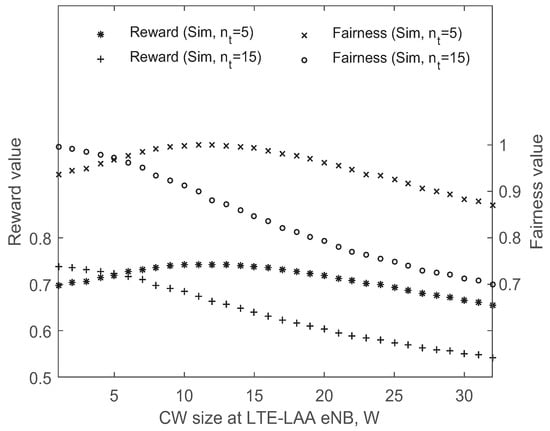
Figure 4.
Reward and fairness values of the proposed CM-LBT system for .
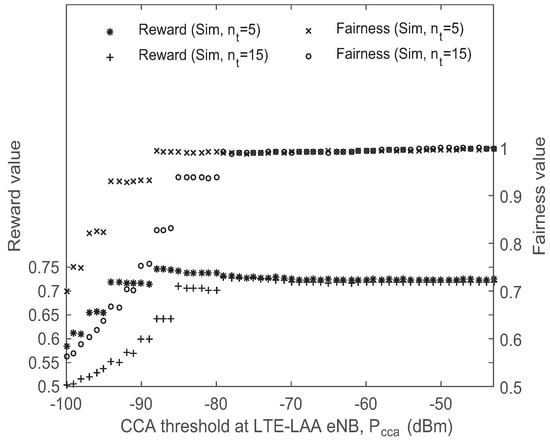
Figure 5.
Reward and fairness values of the proposed CM−LBT system for (dBm).

Table 4.
Average throughput and fairness versus contention window size W in CM-LBT.

Table 5.
Average throughput and fairness versus CCA threshold in CM-LBT.
Figure 6 and Figure 7 present the reward results of CM-LBT, F-LBT, and LB-LBT as q is varied, where and . Our model represents the offered load of LTE-LAA eNB using q, the probability that a packet will become available to the medium access control in a slot [9]. As noted earlier in this section, the packet arrival rates of LTE-LAA and WLAN systems are determined by Equation (22). Figure 6 shows that CM-LBT performs better than both F-LBT and LB-LBT. On average, when 5, the reward value of CM-LBT is 0.43 and 0.4 times higher than that of F-LBT with −62 and −82 dBm, respectively, and 0.44 and 0.41 times higher than that of LB-LBT with −62 and −82 dBm. The same phenomenon is observed when 15 as shown in Figure 7, where the reward value of CM-LBT is 0.41 and 0.21 times higher than that of F-LBT with −62 and −82 dBm, respectively, and 0.42 and 0.22 times higher than that of LB-LBT with −62 and −82 dBm, respectively.

Figure 6.
Reward values for CM-LBT, F-LBT, and LB-LBT systems versus q, where .
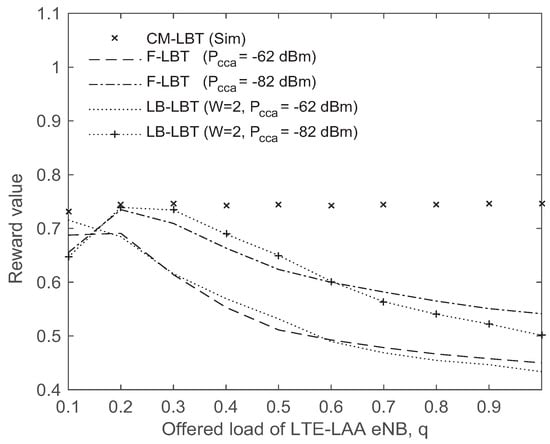
Figure 7.
Reward values for CM-LBT, F-LBT, and LB-LBT systems versus q, where .
Note that CM-LBT guarantees the fairness between LTE-LAA and WLAN by adaptively adjusting W and parameters. Conversely, in both F-LBT and LB-LBT, when q increases, the WLAN throughput decreases, whereas that of the LTE-LAA system largely increases. As a result, the fairness in both F-LBT and LB-LBT decreases with an increase in q. Meanwhile, when 15, the reward value is greater for dBm than for dBm in both F-LBT and LB-LBT, as shown in Figure 7. This can be attributed to the fact that when , the number of WLAN basic service sets in the CCA range is larger for dBm than for dBm. Consequently, in both F-LBT and LB-LBT, the fairness in the case of dBm is improved because the gap between the throughputs achieved by LTE-LAA and WLAN is reduced when compared to the case of dBm.
Lastly, Figure 8 and Figure 9 plot the reward results of CM-LBT, F-LBT, and LB-LBT under different offered loads per WLAN node, . We assume q equals 0.1. We see from Figure 8 that CM-LBT can improve the reward values in F-LBT and LB-LBT. Specifically, when , the reward value in CM-LBT is increased on average by 0.1 and 0.01 times compared to F-LBT with −62 and −82 dBm, respectively, and by 0.07 and 0.02 times as compared to LB-LBT with −62 and −82 dBm. In the case of , CM-LBT outperforms F-LBT and LB-LBT. As shown in Figure 9, it improves the reward result of F-LBT with −62 and −82 dBm by 0.1 and 0.15 times, and the reward of LB-LBT with −62 and −82 dBm by 0.05 and 0.12 times.
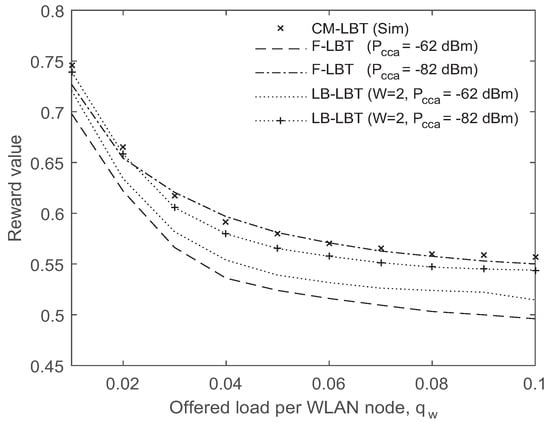
Figure 8.
Reward values for CM−LBT, F−LBT, and LB−LBT systems versus , where .
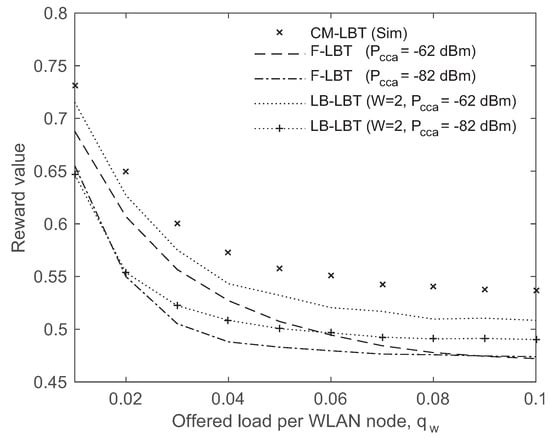
Figure 9.
Reward values for CM−LBT, F−LBT, and LB−LBT systems versus , where .
However, Figure 8 and Figure 9 show that the reward value of CM-LBT also decreases as increases. Thus, because the collision probability among WLAN nodes increases with increases in , the total system throughput in CM-LBT decreases as increases. Meanwhile, the same figures show that when , the reward value in both F-LBT and LB-LBT is greater for dBm than for dBm. On the other hand, when , it is the opposite in most cases. This can be explained as follows. The number of BSSs in the CCA range, , is larger in the case of and −82 than in the other cases. Thus, when and −82, the channel is sensed as busy with a high probability, resulting in a failure of the LTE-LAA system in retrieving channel access. When 1 and 2, LTE-LAA can access the channel with the probabilities of 0.19 and 0.07, respectively, under the assumption of saturated traffic for the WLAN nodes.
5. Conclusions
The LB-LBT mechanism is regarded as a mandatory feature of the LTE-LAA system for sharing channels with incumbent WLAN systems, owing to its flexible spectrum utilization and adaptability to varying traffic loads compared to the FB-LBT scheme. However, many existing LB-LBT schemes employ a fixed contention window size and CCA threshold at the LTE-LAA eNB, regardless of the congestion status on the unlicensed channel. This leads to a reduction in overall system throughput and causes performance imbalances between LTE-LAA and WLAN systems. In this paper, we, therefore, proposed a CM-LBT scheme that adaptively adjusts both the CCA threshold and contention window size based on the channel access activities of LTE-LAA and WLAN systems. To evaluate its performance, we conducted simulations comparing the CM-LBT scheme with existing LBT schemes. The simulation results demonstrate that our proposed scheme outperforms both the F-LBT and conventional LB-LBT schemes significantly.
Funding
This work was supported by the Institute of Information & Communications Technology Planning & Evaluation (IITP) under the Metaverse support program to nurture the best talents (IITP-2024-RS-2023-00254529) grant funded by the Korean government (MSIT), and this research was supported by the MSIT (Ministry of Science and ICT), Korea, under the ITRC (Information Technology Research Center) support program (IITP-2024-2021-0-01816) supervised by the IITP (Institute for Information & Communications Technology Planning & Evaluation). This work was also supported by the National Research Foundation of Korea (NRF) grant funded by the Korean government (MSIT) (no. NRF-2022R1G1A1012117).
Data Availability Statement
Data are contained within the article.
Conflicts of Interest
The author declares no conflicts of interest.
References
- Yairnezhad, R.; Ekici, E. A novel scheduling algorithm for LTE on unlicensed bands to ensure fair coexistence with Wi-Fi. Comput. Netw. 2024, 241, 110232. [Google Scholar] [CrossRef]
- Baur, H. Heterogeneous networks—Meeting mobile broadband expectations with maximum efficiency. Elektrotech. Inftech. 2012, 129, 416–421. [Google Scholar] [CrossRef]
- Review of Regulatory Requirements for Unlicensed Spectrum. Available online: https://www.3gpp.org/ftp/workshop/2014-06-13_LTE-U/Docs/RWS-140015.zip (accessed on 6 December 2024).
- Progress on LAA and Its Relationship to LTE-U and MulteFire. Available online: https://www.qualcomm.com/media/documents/files/laa-webinar-feb-2016.pdf (accessed on 6 December 2024).
- Ko, H.; Lee, J.; Pack, S. A Fair Listen-Before-Talk Algorithm for Coexistence of LTE-U and WLAN. IEEE Trans. Veh. Technol. 2016, 65, 10116–10120. [Google Scholar] [CrossRef]
- Zhang, R.; Wang, M.; Cai, L.X.; Shen, X.; Xie, L.L.; Cheng, Y. Modeling and Analysis of MAC Protocol for LTE-U Co-existing with Wi-Fi. In Proceedings of the 2015 IEEE Global Communications Conference (GLOBECOM), San Diego, CA, USA, 6–10 December 2015; pp. 1–6. [Google Scholar]
- Jeon, J.; Niu, H.; Li, Q.; Papathanassiou, A.; Wu, G. LTE with listen-before-talk in unlicensed spectrum. In Proceedings of the 2015 IEEE International Conference on Comunication Workshop (ICCW), London, UK, 8–12 June 2015; pp. 2320–2324. [Google Scholar]
- Song, Y.; Sung, K.W.; Han, Y. Coexistence of Wi-Fi and Cellular With Listen-Before-Talk in Unlicensed Spectrum. IEEE Commun. Lett. 2016, 20, 161–164. [Google Scholar] [CrossRef]
- Malone, D.; Duffy, K.; Leith, D. Modeling the 802.11 Distributed Coordination Function in Nonsaturated Heterogeneous Conditions. IEEE/ACM Trans. Netw. 2007, 15, 159–172. [Google Scholar] [CrossRef]
- Martorell, G.; Femenias, G.; Riera-Palou, P. Non-saturated IEEE 802.11 networks. A hierarchical 3D Markov model. Comput. Netw. 2015, 80, 27–50. [Google Scholar] [CrossRef]
- Guo, Z.; Li, M.; Krunz, M. Exploiting Successive Interference Cancellation for Spectrum Sharing Over Unlicensed Bands. IEEE Trans. Mob. Comput. 2024, 23, 2438–2455. [Google Scholar] [CrossRef]
- Samy, I.; Han, X.; Lazos, L.; Li, M.; Xiao, Y.; Krunz, M. Misbehavior Detection in Wi-Fi/LTE Coexistence over Unlicensed Bands. IEEE Trans. Mob. Comput. 2023, 22, 4773–4791. [Google Scholar] [CrossRef]
- Lee, H.; Yang, H.J. Downlink MU-MIMO LTE-LAA for Coexistence with Asymmetric Hidden Wi-Fi APs. IEEE Trans. Mob. Comput. 2022, 21, 93–109. [Google Scholar] [CrossRef]
- Saleem, R.; Alvi, S.A.; Durrani, S. Performance-Fairness Trade-off for Wi-Fi and LTE-LAA Coexistence. IEEE Access 2021, 9, 62446–62456. [Google Scholar] [CrossRef]
- Zhang, Y.; Gao, Y.; Wang, L.; Wang, Y.; Wang, Y. Performance Analysis of an LAA and WiFi Coexistence System Using the LAA Category-4 LBT Procedure With GAP. IEEE Trans. Veh. Technol. 2021, 70, 6246–6258. [Google Scholar] [CrossRef]
- Feasibility Study on Licensed-Assisted Access to Unlicensed Spectrum. Available online: https://portal.3gpp.org/desktopmodules/Specifications/SpecificationDetails.aspx?specificationId=2579 (accessed on 6 December 2024).
- Jeon, J.; Niu, H.; Li, Q.C.; Papathanassiou, A.; Wu, G. LTE in the unlicensed spectrum: Evaluating coexistence mechanisms. In Proceedings of the 2014 IEEE Globecom Workshops (GC Wkshps), Austin, TX, USA, 8–12 December 2014; pp. 740–745. [Google Scholar]
- Kelif, J.M.; Coupechoux, M.; Godlewski, P. A Fluid Model for Performance Analysis in Cellular Networks. EURASIP J. Wirel. Commun. Netw. 2010, 2020, 435189. [Google Scholar] [CrossRef][Green Version]
- Liu, F.; Bala, E.; Erkip, E.; Beluri, M.C.; Yang, R. Small Cell Traffic Balancing Over Licensed and Unlicensed Bands. IEEE Trans. Veh. Technol. 2015, 12, 5850–5865. [Google Scholar] [CrossRef]
- Mogensen, P.; Na, W.; Kovács, I.Z.; Frederiksen, F.; Pokhariyal, A.; Pedersen, K.I.; Kolding, T.; Hugl, K.; Kuusela, M. LTE Capacity Compared to the Shannon Bound. In Proceedings of the 2007 IEEE 65th Vehicular Technology Conference—VTC2007-Spring, Dublin, IE, USA, 22–25 April 2007; pp. 1234–1238. [Google Scholar]
- Whitehouse, K.; Woo, A.; Jiang, F.; Polastre, J.; Culler, D. Exploiting the capture effect for collision detection and recovery. In Proceedings of the Second IEEE Workshop on Embedded Networked Sensors, 2005, EmNetS-II, Sydney, NSW, Australia, 31 May 2005; pp. 45–52. [Google Scholar]
- IEEE Std 802.11-2007. Available online: https://standards.ieee.org/ieee/802.11/3605/ (accessed on 6 December 2024).
- Jain, R.; Chiu, D.-M.W.; Hawe, W.R. A Quantitative Measure of Fairness and Discrimination. East. Res. Lab. Digit. Equip. Corp. 1984, TR-301, 1–18. [Google Scholar] [CrossRef]
- Chong, E.K.P.; Zak, S.H. An Introduction to Optimization, 3rd ed.; John Wiley & Sons: New York, NY, USA, 2008; ISBN 0-471-75800-0. [Google Scholar]
- Jeon, J.; Li, Q.C.; Niu, H.; Papathanassiou, A.; Wu, G. LTE in the unlicensed spectrum: A novel coexistence analysis with WLAN systems. In Proceedings of the 2014 IEEE Global Communications Conference, Austin, TX, USA, 8–12 December 2014; pp. 3459–3464. [Google Scholar]
- ETSI EN 301 893 V1.7.2 (2014-07). Available online: https://www.etsi.org/deliver/etsi_en/301800_301899/301893/01.07.02_20/en_301893v010702a.pdf (accessed on 6 December 2024).
Disclaimer/Publisher’s Note: The statements, opinions and data contained in all publications are solely those of the individual author(s) and contributor(s) and not of MDPI and/or the editor(s). MDPI and/or the editor(s) disclaim responsibility for any injury to people or property resulting from any ideas, methods, instructions or products referred to in the content. |
© 2024 by the author. Licensee MDPI, Basel, Switzerland. This article is an open access article distributed under the terms and conditions of the Creative Commons Attribution (CC BY) license (https://creativecommons.org/licenses/by/4.0/).